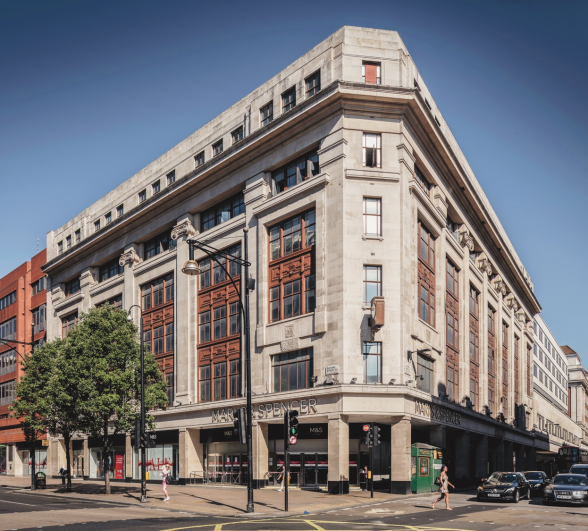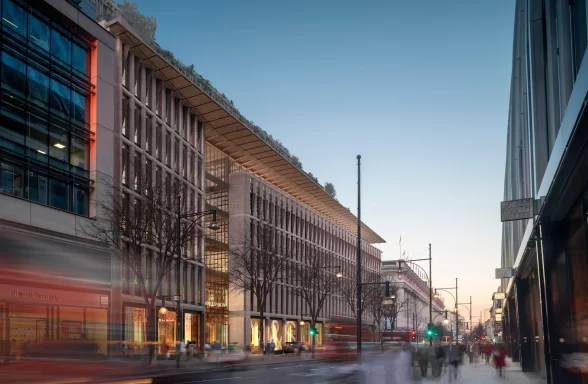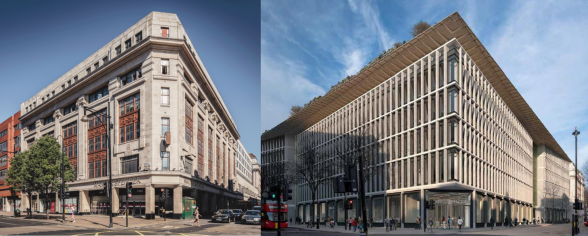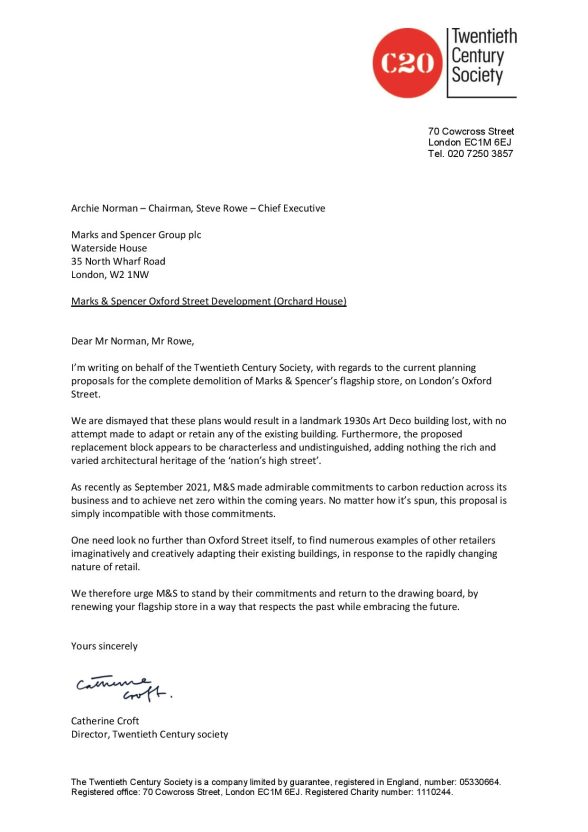This website uses cookies
This website uses cookies to enable it to function properly and to analyse how the website is used. Please click 'Close' to accept and continue using the website.



Image – John East
As the backlash continues to grow around Marks & Spencer’s controversial plans for the demolition of their flagship store on London’s Oxford Street, C20 Society has taken the step of writing an open letter to the iconic British retailer, urging them back to the drawing board.
Designed and built 1929-30, Orchard House is the work of architects Alfred Frederick Aldridge Trehearne (1874-1962) and Charles Frederick Norman (1884-1925), in the ‘Neo-Grec’ style – a variant on classicism and forerunner to Art Deco. It sits at the junction of Oxford Street and Orchard Street, providing a playful and deferential neighbour to the more grandiose elevations of the Grade II* listed Selfridges, immediately adjacent. At one point, the six storey Portland stone and marble facade even carried sculpted heads of characters from Lewis Carroll’s novels, though these only partially survive.
After our attempts to have the building listed proved unsuccessful, Westminster Council granted planning approval in November 2021 for the proposals by Pilbrow & Partners to demolish the 1930’s Orchard House, a 1970’s extension to the rear, plus the adjoining 1980s Neale House on Oxford Street.

Image: Pilbrow & Partners
As environmental arguments take increasing precedent in such planning debates, calculations by the AJ have indicated that up to 50,000 tonnes of embodied carbon would be released in the demolition of the current site and construction of the proposed new building – requiring 2.4 million trees to offset. This calls into question, whether the ambitious recent commitments to carbon reduction by both M&S and Westminster Council, are simply incompatible with this development.
C20 believes the scope for an imaginative retrofit scheme has yet to be fully explored; this could breath new life into the 92 year old flagship store, accommodating a variety of different uses and making it fit-for-purpose for the next century, rather than becoming another lost landmark from the past.
We must acknowledge that as shopping habits and the relationship with our high streets are changing rapidly, so retailers are being forced to adapt. The C20 Department Store Campaign has highlighted dozens of sites across the country, where architecturally significant retail buildings are now at risk of being lost, yet many others are being creatively repurposed for hybrid retail, leisure and hospitality uses, or taken over by local community organisations. In the past few weeks alone, this story has been covered widely in the national and built-environment media – the likes of The Times, Telegraph, The Guardian, FT, Daily Mail and BBC London – demonstrating the strength of public feeling on the threat to part of our shared social history.
The rich architectural heritage of Oxford Street also gives the West End a unique sense of place and helps make it the UK’s most iconic shopping destination: where it leads, others follow. By rethinking their plans, M&S now have an opportunity to set the benchmark for renewing tired flagship stores – respecting the past, while boldly embracing the future.

Images: John East / Pilbrow & Partners
Read C20’s open letter to the chairman and chief executive Marks & Spencer below, and sign our joint petition with SAVE Britain’s Heritage by clicking here.
Dear Mr Norman, Mr Rowe,
I’m writing on behalf of the Twentieth Century Society, with regards to the current planning proposals for the complete demolition of Marks & Spencer’s flagship store, on London’s Oxford Street.
We are dismayed that these plans would result in a landmark 1930s Neo-Grec building lost, with no attempt made to adapt or retain any of the existing building. Furthermore, the proposed replacement block appears to be characterless and undistinguished, adding nothing the rich and varied architectural heritage of the ‘nation’s high street’.
As recently as September 2021, M&S made admirable commitments to carbon reduction across its business and to achieve net zero within the coming years. No matter how it’s spun, this proposal is simply incompatible with those commitments.
One need look no further than Oxford Street itself, to find numerous examples of other retailers imaginatively and creatively adapting their existing buildings, in response to the rapidly changing nature of retail.
We therefore urge M&S to stand by their commitments and return to the drawing board, by renewing your flagship store in a way that respects the past while embracing the future.
Yours sincerely,
Catherine Croft
Director, Twentieth Century Society


Become a C20 member today and help save our modern design heritage.